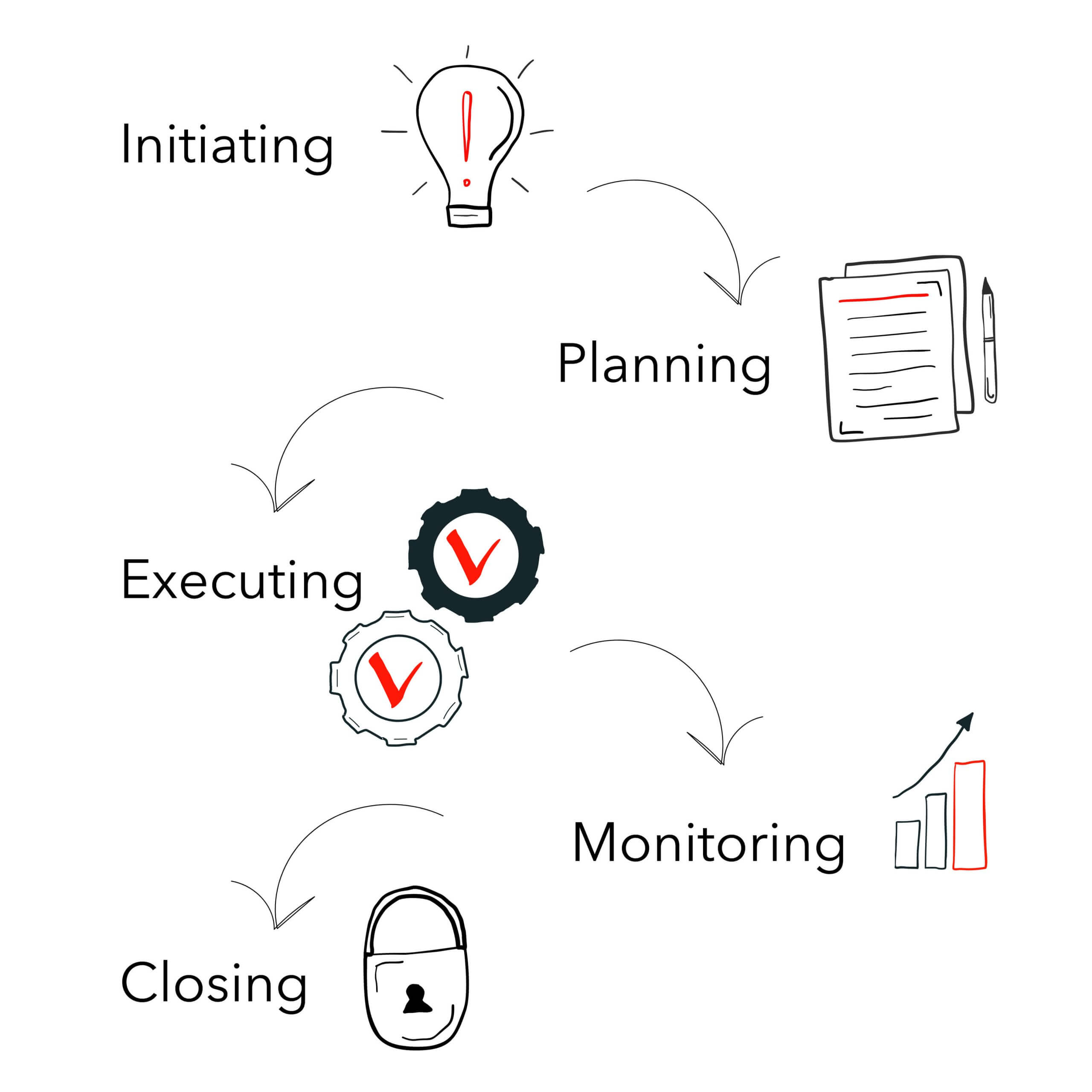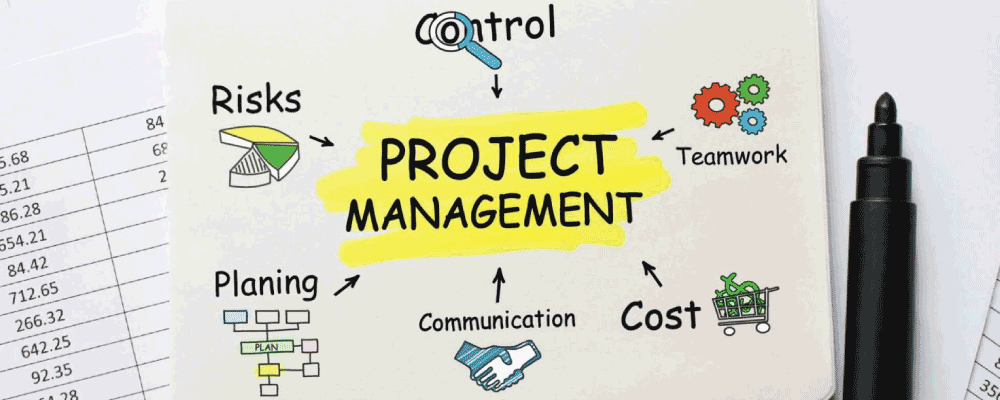So, here you are at the start of your new career: project management. In this guide, Fred Wilson will explain what is project management, the project management lifecycle, and the most effective techniques.
Here is the deal:
Project management can potentially be the most attractive and rewarding career choice you will make.
You’ll be leading people from different functions and departments, getting things done in a timely manner.
In this guide on what is project management, you’ll learn about the project management lifecycle the true art of project management. It comprises:
- Initiating
- Planning
- Executing
- Monitoring & Controlling
- Closing
What is a project?

Projects come in different shapes and sizes. No two projects are a complete twin of each other.
Can they be similar? Yes, but conditions will dictate how the projects will be managed.
A project is a temporary attempt to create a new product, service, or result.
Projects do not last forever.
Unlike the operations within an organization, projects have a start date and an end date attached to them.
Project Manager: Roles & Responsibilities
To achieve the vision and goals of a project; project managers are appointed to manage the resources and teams to meet the end goal.
The project manager must have a clear vision of what they want to achieve out of the project.
The project manager must inherit the vision from the organization’s senior hierarchy and project sponsor.
To plan well for the project work, the project manager will have to begin with the end in mind.
Like a good soccer manager, the project manager needs to identify the resources they will need during the project and see the end results of the effort before the project begins.
Project Management Life Cycle
A project is like a story. It has a beginning, a middle, and a productive end.
All projects move through 5 process groups to get from the start to finish.
Within each process group, there is a set of activities that will support the project move smoothly in the right direction.
The flow of the project through this set of activities is known as the project management life cycle.
What is Project Management: #1 Lifecycle – Initiating a Project

This is the beginning – where all the fun is.
In this stage of the lifecycle, the initial objectives of the project are listed, and the project sponsor appoints a project manager.
The key output of this stage of the lifecycle is the project charter.
The project charter allocates the time, human resource,s and financial expenditures which will be made part of the project management Lifecycle.
This is mostly done under the supervision of a project sponsor; someone who is high enough in the hierarchy to have control over the factors relevant to the project.
Why do a project?
There can be several reasons why an organization opts to launch projects but, in most cases, it is for cutting costs and expenditure or increasing the revenue of the organization.
But here’s the kicker:
Sometimes new regulatory rules pop up and the organization can do little except comply with those regulations.
Understanding why a specific project is launched can go a long way for you to understand what is your role as a project manager.
Business Analysis of Project Management
Business Analysis (BA) is the study of the project requirements, feasibility, cost as well as the likelihood of managing and achieving the project goals.
What’s the bottom line?
This usually is led by a business analyst and is done before project work begins.
Creating the Project Charter
The project charter is the main document that authorizes the project and the project manager.
It entails as a consequence that the project is authorized to exist within the periphery of the organization’s domain.
It formally allows the project manager to lead and manage all sorts of resources to achieve the project goals and exercise the art of project management to its fullest.
Identifying the Project Stakeholders
Those people who can affect your project or are affected by your project are known as project stakeholders.
When you start off with a project, you’ll want to identify all relevant stakeholders – the project would be redundant if the project stakeholders don’t identify all relevant individuals within the organization.
Identification of stakeholders also is about documenting all relevant perceived threats that the stakeholders might sense.
What is Project Management: #2 – Planning a Project

For planning, the Project Manager must know what the project will establish.
There needs to be an AS-IS state (current state) and the desired Future State which the project manager and the project stakeholders need to agree upon.
A fantasy goal won’t work in project management.
The project manager needs to list down the exact requirements.
If you don’t have the end goal in mind how will you ever achieve the target?
Now:
Once the project requirements have been locked, the project stakeholders, project manager, and project team need to set up a game plan to achieve the target.
You might be wondering?
Is this a one-off exercise or continuous? Most experts believe that this should be iterative in nature and a continuous process throughout the project’s lifetime.
Planning is the foundation stone of project management – if you get this wrong your project is destined for failure.
Defining the Project Management Plan (PMP)
The PMP plan describes how the project will be managed from start to end.
It is an aggregate of different plans.
In the PMP you define how you will strategize, handle and reach the project goals:
- Scope
- Schedule
- Costs
- Human Resources
- Risk
- Communications
- Stakeholders
- Procurement
Writing the Project Scope Statement
In project management, there are typically two different project scopes: Product Scope and Project Scope.
Product Scope is the end goal as far as the product is concerned.
It is the end-use of the product by your users and clients.
On the other hand:
The project scope is the process and effort through which the product scope is achieved and managed.
The product scope and the project scope complement each other.
Creating the Project Schedule
In project management, there is a perceived time frame in which the project will be complete and an actual time in which the project will achieve its goals.
Let’s for a second think that we are living in the perfect project management universe and everything will happen as planned.
First, we will work with the customer to establish the product scope.
Subsequently, we will set up the project scope.
An activity list is populated based on the project scope.
The activities within the activity list should be set up in an order of priority with respect to completion.
Many of the activities normally must rely on logic; they must be in a sequence for the project to be successful.
Likewise, some activities must rely on soft logic. It relies on management discretion.
Through soft logic, we can decide whether to complete a task in a fashion or not.
Its preferential reasoning is based on skill, nature of work, or even your attitude on a day or week.
Estimating the Costs of a Project

How do you determine how much a project will cost?
You can’t really ascertain the exact amount until or unless the project is complete. This is true as you can’t predict the future.
What you can do though is to create an estimate.
Project estimate hone’s in on the perceived cost by utilizing all relevant information pertaining to the project.
Each estimate should comprise an estimated amount of variance as well. It should contain the estimated percentage as well as the conditions of the estimate made.
Planning the Project Quality
Project quality and targets might vary from organization to organization.
Some organizations might state “We believe project quality relates to when the job gets done”.
Other organizations might benchmark project quality on when payments are made by clients.
Some organizations have subscribed to quality programs like Lean Manufacturing and ISO 9000.
Planning of Quality means that the project is executed in line with the expectations set at the beginning with respect to quality standards.
Planning to Manage Project Risks
As a project manager, you always need to keep a lookout for any risks that can cause the project to fail.
Not only the project manager but the entire project team needs to be on the lookout for such risks.
Risk identification exists from project launch to project completion.
There needs to be a continuous process of risk identification.
A risk management approach, in its true form, has steps for risk documentation and categorization, and the process for risk evaluation.
What is Project Management: #3 – Executing a Project

All planning is completely worthless unless it’s acted upon.
You’ll need to ensure that the project team is executing the project work properly.
You’ll need to arrange regular update meetings with the project team and provide an update to relevant stakeholders.
And you’ll need to ensure that the project stakeholders are adequately engaged and participative in the process.
To do all of this, you need to make sure that you have a project pipeline tracker or project pipeline software so that your stakeholders can know what is happening with the project and the people working on it.
Doing the Project Work
In this part of the process, the project manager works with internal and external stakeholders/vendors to support the deliverables which are required for project completion.
It’s all about Getting Things Done.
Managing the Project Team
Human Resource Management is the most critical and difficult part of project management.
You might often wonder…
Why doesn’t the project team just do what they have been assigned?
That’s the job of a project manager and a senior one at that.
Project managers must provide the right amount of management and leadership to their project team.
Hosting Effective and Valuable Project Team Meetings
All must agree that we’ve all attended meetings which were a complete waste of time.
Often, stakeholders end up joining a meeting without having prepared their side of the story – which is a horrible experience.
As a project manager, you need to know how to lead and manage project team meetings.
Communicating Project Status
Project stakeholders especially project sponsors need to know the status of a project at a given time.
Communication is more than just talking – it also involves attentive listening.
90% of all projects involve active back and forth communication.
Active communication involves transferring knowledge.
There are broadly speaking two forms of communication that are involved in project management: Oral and Written.
Managing Project Stakeholders
The job of a project manager is not just to manage the project team, you need to manage and communicate with all internal and external stakeholders relevant to the project.
The central cog of managing stakeholders involves active communication – not just communicating what’s the status of the project but also addressing stakeholder concerns.
In addition, you also need to keep your stakeholders engaged.
You want your stakeholders to be involved and take ownership of the project vision.
You don’t want your stakeholders to lose interest in your project.
What is Project Management: #4 – Monitoring & Controlling a Project

Controlling a project doesn’t mean you micromanage – it requires you to control the factors so that project deliverables are met.
There needs to be a balance between control and execution.
What’s the best way for a project manager to achieve this end…
I would recommend that the project manager works alongside the project team rather than over it.
A successful project manager must control, balance, and recalibrate certain factors to manage the end goal.
As a rule of thumb, if you don’t measure how close you are to your goal it will be difficult to control the factors relevant to achieving the end.
So always have the end in mind…
Controlling the Project Work
Controlling the project work will ensure that the project is completed on time with the right results and within the budget.
In fact, there is a back-and-forth link between controlling and executing the project.
You can also use a project management tool like nTask to be a project pipeline tracker. This project pipeline software can make sure that all of the tasks and processes that are a part of the project development pipeline are well tracked and properly moderated.
Managing and Controlling the Project Team
The largest influence on whether the project will be a success or not is dependent upon how the project team is led and managed.
If the project team is not in compliance with the project charter and does give attentive listen to the project manager then the project is destined for disaster.
Managing is also an art…
Good project managers do not become stumbling blocks or micromanagers of their project team.
We want the project team to take ownership of their individual responsibilities within the project and become a cohesive unit.
Controlling Project Communications
A successful project manager must have multiple sources and channels of communication with the project team.
This will ensure that the project manager is aware of each technical and non-technical happening within the project team.
So, every project manager must ensure they utilize attentive listening and communication so that correspondence with the project team does not break down.
Keeping Project Stakeholders Engaged
Stakeholders may be internal or external team members.
They could be anyone who has a vested interest in the project or the outcomes of the project.
Therefore, it is essential that the project stakeholders are engaged and kept abreast of all the important happenings within the project.
What is Project Management: #5 – Closing a Project

Alas… we reach the last component of project management.
This group centers around finalizing the project deliverables, any relevant report writing, completing any audits as well as doing a sanity check of the entire project.
The project manager might have to potentially review his own performance and his team & also review any vendors that might have been involved in the process.
Project closure in some cases also entails some sort of recognition which could be in the form of a bonus, vacation, or certificate of appreciation.
At the bare minimum, the project manager should verbally thank their team for all the effort they put in during the lifecycle of the project.
Customer Acceptance
How do you know that the project is complete?
Essentially, the project can only be considered as being complete when the project scope has been achieved.
You need to do a scope verification which will lead to customer acceptance.
Basically…
You need to ensure that all the commitments made at the start of the project have been met at the closure state.
Closing the Project
Project closure involves filing a final report and a final review of the project with the project team.
Closing the project well will lead to a successful engagement for the future as well as the stakeholders.

-
nTask is a perfect project management tool
nTask is free and lets you create & manage unlimited tasks, meetings, issues, risks and more.
- Get Started for Free

